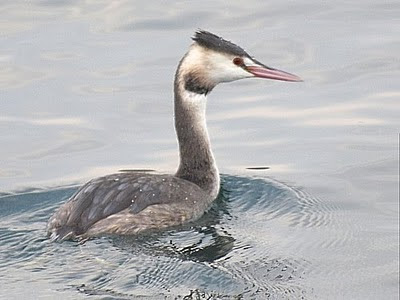5/11/10: Calm conditions with heavy cloud that cleared by mid-morning becoming warm and sunny. Good numbers of Eye-browed and Dusky Thrushes were seen both arriving and departing soon after dawn and we saw a few more flocks of Waxwings totalling 44 individuals were encountered during the morning. A Great Crested Grebe was found in the harbour immediately after breakfast and we found a newly-arrived male Pallas’s Reed Bunting and saw a pair of Korean Bullfinches at Tsukasa. Six Sparrowhawks were seen in the air together proving the daily maximum for the species. A new European Starling was seen drinking at the Dragon’s Pool and two fine male Long-tailed Rosefinches were seen alongwith a female along the Central Track. Covering the island in calm conditions produced a total of 8 Siberian Accentors far exceeding our pre-trip expectations with local birders suggesting it was probably a record day count for Japan

Slaty-backed Gull at the Harbour


Vega Gull at the Harbour

Our host and his fishing boat




Great Crested Grebe in the Harbour

Naumann's Thrush



Siberian Accentor at the southern tip of the island



Chestnut-eared Bunting along the western shore


First-winter male Daurian Redstart at the southwest beach







Common Reed Bunting near the Harbour
Byers et al. (1995) includes E.s. pyrrhulina of North-east Siberia,
Based on its large bill with convex culmen it seems straightforward to assign this individual to pyrrhulina. That said, it appeared easily the largest-billed individual encountered and its overall size struck us as noticeably large too. Its pointed tail feathers suggest a first-winter and its somewhat contrasting head pattern a male. Measurements included in BWP would indicate Japanese pyrrhulina average larger-billed than those from southeast Siberia so perhaps this individual originates from Hokkaido

Siberian Accentor at Tsukasa


Common Reed Bunting
Based on lacking the shadow of a dark bib, its rounded tail feathers and what appear to be greyish tips to its primary coverts this is an adult female. This female appeared tiny in the field but clearly possessed a convex culmen shared by the ‘medium sized’ forms pyrrhulina and pallidior. Reassuringly it appears a very close match to the adult female pyrrhulina depicted in Byers et al. (1995). Perhaps its small bill suggests a southeastern Siberian origin rather than the on average larger-billed individuals from Holkkaido?











Common Reed Bunting
The rufous caps of these females with convex culmens would all appear likely pyrrhulina. Perhaps its small bill suggests a southeastern Siberian origin rather than the on average larger-billed individuals from Hokkaido









Common Reed Buntings north of Tsukasa
Based on the shadow of a dark bib, its rounded tail feathers and what appear to be greyish tips to its primary coverts this is an adult male. In the western European context its two-toned bill, pale rump, sparse underpart streaking and even buff hindcollar might prove a trap for the unwary in considering Pallas’s Reed Bunting but its overall large size, rufous lesser coverts, bib and call should soon dispel such thoughts. As this male clearly possessed a smaller bill than that above perhaps it suggests a southeastern Siberian origin E.s. pyrrhulina although as there seems so much to learn we don’t pretend to know whether the albeit seemingly far less-likely form E.s. palliodior can be safely eliminated....
Byers et al. (1995) includes E.s. pallidior of South-west Siberia in the ‘intermediate group’ of medium size and intermediate-billed forms. They describe this form as a medium-sized and very pale. BWP states very pale, ground-colour of upperparts sandy-buff, of underparts buff-white; rump grey-white when worn; dark streaks on upperparts and flanks rather narrow, tinged black-brown on lower mantle and scapulars, brown and reduced in extent on cap, back, and flank.


Masked Bunting north of Tsukasa









Siberian Accentors at Tsukasa



Male Korean Bullfinch at Tsukasa


Bull-headed Shrike at the Lighthouse

The western Shrines

The west coast pine belt


Male Long-tailed Rosefinch along the Central Track





Grey-streaked Flycatcher at the Lighthouse


Skylark at Tsukasa
Species noted:
Streaked Shearwater 1
Cormorant 20
Great Egret 2
Grey Heron 2
Mandarin Duck 2
Mallard 1
Black-eared Kite 1
Sparrowhawk 6
Black-tailed Gull 50
Vega Gull 5
Slaty-backed Gull 10
Japanese Woodpigeon 1
Rufous Turtle Dove 5
Great Spotted Woodpecker 1
Skylark 15
Siberian Buff-bellied Pipit 10
Black-backed Wagtail 5
Brown-eared Bulbul 3
Waxwing 44
Siberian Accentor 8
Siberian Rubythroat 1 female
Daurian Redstart 20
Blue Rock Thrush 5
Pale Thrush 1
Eye-browed Thrush 21, 12S
Dusky Thrush 30, 45S
Naumann's Thrush 4
Japanese Bush Warbler 10
Goldcrest 20
Grey-streaked Flycatcher 1
Red-breasted Flycatcher 1
Coal Tit 4
Japanese White-eye 10
Bull-headed Shrike 1
Eastern Rook 3
Large-billed Crow 4
White-cheeked Starling 11
European Starling 1
Brambling 50
Siskin 50
Mealy Redpoll 25
Long-tailed Rosefinch 3 (2 males)
Korean Bullfinch 1 male
Hawfinch 50
Grey Bunting 4
Masked Bunting 10
Pine Bunting 1
Chestnut-eared Bunting 1
Elegant Bunting 50
Rustic Bunting 50
Reed Bunting 6
Pallas's Reed Bunting 1 male











